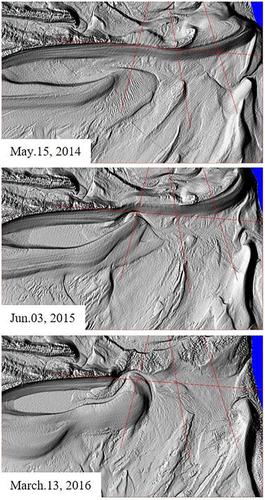当前位置:
X-MOL 学术
›
Earth Surf.Process. Land.
›
论文详情
Our official English website, www.x-mol.net, welcomes your
feedback! (Note: you will need to create a separate account there.)
Sand spit dynamics in a large tidal‐range environment: Insight from multiple LiDAR, UAV and hydrodynamic measurements on multiple spit hook development, breaching, reconstruction, and shoreline changes
Earth Surface Processes and Landforms ( IF 2.8 ) Pub Date : 2020-06-26 , DOI: 10.1002/esp.4924 Nicolas Robin 1 , Franck Levoy 2 , Edward J. Anthony 3, 4 , Olivier Monfort 2
Earth Surface Processes and Landforms ( IF 2.8 ) Pub Date : 2020-06-26 , DOI: 10.1002/esp.4924 Nicolas Robin 1 , Franck Levoy 2 , Edward J. Anthony 3, 4 , Olivier Monfort 2
Affiliation

|
Sand spits with distal hooks have been well documented from coasts with low to moderate tidal ranges, unlike high tidal‐range environments. Datasets from 15 LiDAR and 3 UAV surveys between 2009 and 2019 on the Agon spit in Normandy (France), a setting with one of the largest tidal ranges in the world (mean spring tidal range: 11 m), combined with in‐situ hydrodynamic records between 2013 and 2017, highlight a three‐stage pattern of spit hook evolution. Stage 1 (2009–2013) commenced with the onshore migration and attachment of a swash bar, followed by persistent spit accretion updrift of the bar and erosion downdrift because of the slow speed of bar migration in this large tidal‐range environment. In stage 2 (2013–2016), three overwash events and a 220 m‐wide breach culminating in the total destruction of the spit during winter 2015–2016 involved the landward mobilization of thousands of cubic metres of sand. These events occurred during short durations (a few hours) when spring high tides coincided with relatively energetic waves, underscoring the importance of storms in rapid spit morphological change. Strong spring tidal currents maintained the breach. Stage 3 (2016–2019) has involved new hook construction through welding of a swash bar and spit longshore extension, highlighting the resilience of the spit over the 10‐year period, and involving a positive sediment balance of 244 000 m3. The three stages bring out, by virtue of the temporal density of LiDAR and UAV data used, a high detail of spit evolution relative to earlier studies in this macrotidal setting. The large tidal range strongly modulates the role of waves and wave‐generated longshore currents, the main process drivers of spit evolution, by favouring long periods of inertia in the course of the spring–neap tidal cycle, but also brief episodes of significant morphological change when storm waves coincide with spring high tides. © 2020 John Wiley & Sons, Ltd.
中文翻译:

大型潮汐环境中的沙坑动力学:从多个LiDAR,UAV和水动力测量中了解多个沙坑钩的发育,破坏,重建和海岸线变化
与高潮差环境不同,潮汐范围低至中度的沿海地区已充分记录了带有远侧钩的沙嘴。来自2009年至2019年之间在法国诺曼底Agon口进行的15次LiDAR和3次无人飞行器测量的数据集,该环境是世界上最大的潮汐范围之一(平均春潮范围:11 m),并结合了原位2013年至2017年之间的水动力记录强调了吐钩演变的三个阶段模式。第一阶段(2009-2013年)始于斜盘在岸上的迁移和附着,然后由于在这种大的潮汐环境中,棒的迁移速度较慢,因此棒的吐出力持续不断地上升,而侵蚀逐渐下降。在第2阶段(2013-2016年)中,三起过冲事件和220 m宽的裂口最终导致在2015-2016年冬季对沙坑的彻底破坏,涉及向地面移动数千立方米的沙子。这些事件发生在短时间内(几小时),当时春季的高潮与相对高能的波浪相吻合,突显了风暴对快速吐出形态变化的重要性。强劲的春季潮流保持了突破口。3。相对于此大潮汐环境中的早期研究,这三个阶段凭借所使用的LiDAR和UAV数据的时间密度,揭示了唾液演变的高细节。较大的潮汐范围通过促进春季至潮汐周期过程中的长时间惯性以及强烈的形态变化而强烈地调节了波浪和波浪产生的近岸海流的作用,海浪是吐水演变的主要过程驱动力。当风暴潮与春季高潮相吻合时。分级为4 +©2020 John Wiley&Sons,Ltd.
更新日期:2020-06-26
中文翻译:

大型潮汐环境中的沙坑动力学:从多个LiDAR,UAV和水动力测量中了解多个沙坑钩的发育,破坏,重建和海岸线变化
与高潮差环境不同,潮汐范围低至中度的沿海地区已充分记录了带有远侧钩的沙嘴。来自2009年至2019年之间在法国诺曼底Agon口进行的15次LiDAR和3次无人飞行器测量的数据集,该环境是世界上最大的潮汐范围之一(平均春潮范围:11 m),并结合了原位2013年至2017年之间的水动力记录强调了吐钩演变的三个阶段模式。第一阶段(2009-2013年)始于斜盘在岸上的迁移和附着,然后由于在这种大的潮汐环境中,棒的迁移速度较慢,因此棒的吐出力持续不断地上升,而侵蚀逐渐下降。在第2阶段(2013-2016年)中,三起过冲事件和220 m宽的裂口最终导致在2015-2016年冬季对沙坑的彻底破坏,涉及向地面移动数千立方米的沙子。这些事件发生在短时间内(几小时),当时春季的高潮与相对高能的波浪相吻合,突显了风暴对快速吐出形态变化的重要性。强劲的春季潮流保持了突破口。3。相对于此大潮汐环境中的早期研究,这三个阶段凭借所使用的LiDAR和UAV数据的时间密度,揭示了唾液演变的高细节。较大的潮汐范围通过促进春季至潮汐周期过程中的长时间惯性以及强烈的形态变化而强烈地调节了波浪和波浪产生的近岸海流的作用,海浪是吐水演变的主要过程驱动力。当风暴潮与春季高潮相吻合时。分级为4 +©2020 John Wiley&Sons,Ltd.











































 京公网安备 11010802027423号
京公网安备 11010802027423号